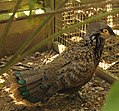Superregnum: Eukaryota
Cladus: Unikonta
Cladus: Opisthokonta
Cladus: Holozoa
Regnum: Animalia
Subregnum: Eumetazoa
Cladus: Bilateria
Cladus: Nephrozoa
Superphylum: Deuterostomia
Phylum: Chordata
Subphylum: Vertebrata
Infraphylum: Gnathostomata
Megaclassis: Osteichthyes
Cladus: Sarcopterygii
Cladus: Rhipidistia
Cladus: Tetrapodomorpha
Cladus: Eotetrapodiformes
Cladus: Elpistostegalia
Superclassis: Tetrapoda
Cladus: Reptiliomorpha
Cladus: Amniota
Classis: Reptilia
Cladus: Eureptilia
Cladus: Romeriida
Subclassis: Diapsida
Cladus: Sauria
Infraclassis: Archosauromorpha
Cladus: Crurotarsi
Divisio: Archosauria
Cladus: Avemetatarsalia
Cladus: Ornithodira
Subtaxon: Dinosauromorpha
Cladus: Dinosauriformes
Cladus: Dracohors
Cladus: Dinosauria
Ordo: Saurischia
Cladus: Eusaurischia
Subordo: Theropoda
Cladus: Neotheropoda
Cladus: Averostra
Cladus: Tetanurae
Cladus: Avetheropoda
Cladus: Coelurosauria
Cladus: Tyrannoraptora
Cladus: Maniraptoromorpha
Cladus: Maniraptoriformes
Cladus: Maniraptora
Cladus: Pennaraptora
Cladus: Paraves
Cladus: Eumaniraptora
Cladus: Avialae
Infraclassis: Aves
Cladus: Avebrevicauda
Cladus: Pygostylia
Cladus: Ornithothoraces
Cladus: Ornithuromorpha
Cladus: Carinatae
Parvclassis: Neornithes
Cohors: Neognathae
Cladus: Pangalloanserae
Cladus: Galloanseres
Ordo: Galliformes
Familia: Phasianidae
Subfamilia: Phasianinae
Genus: Polyplectron
Species: P. bicalcaratum - P. chalcurum - - P. germaini - P. inopinatum - P. katsumatae - P. malacense – P. napoleonis – P. schleiermacheri
Name
Polyplectron Temminck, 1813
References
Temminck C.J. 1813. Histoire naturelle générale des Pigeons et des Gallinacés. 2: 1–477, pl. 1–3. J.C. Sepp & Fils, Amsterdam and G. Dufour, Paris. BHL DOI: 10.5962/bhl.title.64844 Reference page. First availability p. 363 BHL
Vernacular names
Deutsch: Pfaufasane
English: Peacock-pheasants
suomi: Täpläfasaanit
Bahasa Indonesia: Kuau-kerdil
日本語: コクジャク属
한국어: 소공작
lietuvių: Poviniai fazanai
Tiếng Việt: Chi Gà tiền
The peacock-pheasants are a bird genus, Polyplectron, of the family Phasianidae, consisting of eight species. They are colored inconspicuously, relying on heavily on crypsis to avoid detection. When threatened, peacock-pheasants will alter their shapes using specialised plumage that when expanded reveals numerous iridescent orbs. The birds also vibrate their plume quills further accentuating their aposematism. Peacock-pheasants exhibit well developed metatarsal spurs. Older individuals may have multiple spurs on each leg. These kicking thorns are used in self-defense.
Taxonomy
The genus Polyplectron was introduced in 1807 by the Dutch zoologist Coenraad Jacob Temminck.[2] The name combines the Ancient Greek polus meaning "many" with plēktron meaning "cock's spur".[3] The type species is the grey peacock-pheasant.[4]
The systematics of the genus are somewhat unclear. Molecular research has revealed that peacock-pheasants are not genetically related to pheasants and only distantly to peafowl. Their closest allies are the Asiatic spurfowl and the crimson-headed partridge, endemic to Borneo. These three genera share the curious tendency for multiple metatarsal spurs. Though they are somewhat divergent morphologically, their skeletons are nearly identical.
The species of Polyplectron diverged at some time between, roughly, the Early Pliocene and the Middle Pleistocene, or 5–1 million years ago. Polyplectron malacense and P. schleiermacheri form a basal radiation around the southern South China Sea together with P. napoleonis, as is confirmed by comparison of biogeography and mtDNA cytochrome b and D-loop as well as the nuclear ovomucoid intron G.[5]
The relationships of the other forms are more poorly understood. P. germaini and P. bicalcaratum are similar in morphology and are nearly parapatric; the molecular data suggests that the latter is a symplesiomorphy. It would appear that P. germaini and P. katsumatae represent an early offshoot of the aforementioned basal radiation. The two montane-adapted species P. chalcurum and P. inopinatum are not derived from a single isolation event, and appear to have acquired more subdued coloration independently. A trend in this genus to lose—not gain—pronounced sexual dimorphism is better supported by biogeographical and molecular data than the alternate scenario.[5]
In 2010 the IOC World Bird List listed the Hainan peacock-pheasant as a species.[6] Following Jean Théodore Delacour, this species has historically been listed as a subspecies of P. bicalcaratum. Prior to reclassification by Delacour, the Hainan peacock-pheasant has been considered a distinct species by several ornithologists. Indeed, when it was first described to science by Katsumata it was considered a distinct species. Prominent organizations including the World Bird List have recently concurred, and species status is currently under review by the Oriental Bird Club.[7] It is considered of utmost importance to have the Hainan peacock-pheasant recognized as a full species due to its endangered status. The Hainan peacock-pheasant is endemic to the island of Hainan, where its population density is very low in its tropical forest habitat on the island and the wild population is declining, making it now severely endangered and among the rarest species in the order Galliformes in China.
Species
| Image | Name | Common name | Distribution |
|---|---|---|---|
 |
Polyplectron napoleonis – formerly P. emphanum | Palawan peacock-pheasant | Philippines |
 |
Polyplectron malacense | Malayan peacock-pheasant | Malay Peninsula from the Isthmus of Kra region southwards |
 |
Polyplectron schleiermacheri | Bornean peacock-pheasant | Borneo |
 |
Polyplectron germaini | Germain's peacock-pheasant | mid-southern Vietnam and far eastern Cambodia |
 |
Polyplectron bicalcaratum | Grey peacock-pheasant | Bangladesh, Northeast India and Southeast Asia |
| Polyplectron katsumatae – split from P. bicalcaratum[6] | Hainan peacock-pheasant | Hainan, China | |
 |
Polyplectron chalcurum | Bronze-tailed peacock-pheasant | Indonesia |
 |
Polyplectron inopinatum | Mountain peacock-pheasant | Malaysia |
References
"Phasianidae". aviansystematics.org. The Trust for Avian Systematics. Retrieved August 5, 2023.
Temminck, Coenraad Jacob (1807). Catalogue systématique du cabinet d'ornithologie et de la collection de quadrumanes (in French and Latin). Amsterdam: Chez C. Sepp Jansz. p. 149.
Jobling, James A. (2010). The Helm Dictionary of Scientific Bird Names. London: Christopher Helm. p. 313. ISBN 978-1-4081-2501-4.
Peters, James Lee, ed. (1934). Check-List of Birds of the World. Vol. 2. Cambridge, Massachusetts: Harvard University Press. p. 130.
Kimball, Rebecca T.; Braun, Edward L.; Ligon, J. David; Lucchini, Vittorio & Randi, Ettore (2001): A molecular phylogeny of the peacock-pheasants (Galliformes: Polyplectron spp.) indicates loss and reduction of ornamental traits and display behaviours. Biol. J. Linn. Soc. 73(2): 187–198. HTML abstract
[1] Archived July 29, 2009, at the Wayback Machine
"OBC Checklist". Orientalbirdimages.org. Archived from the original on October 15, 2012. Retrieved January 16, 2013.
Retrieved from "http://en.wikipedia.org/"
All text is available under the terms of the GNU Free Documentation License

